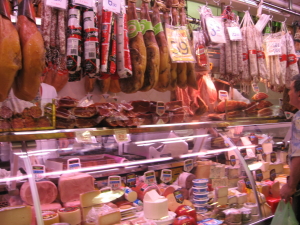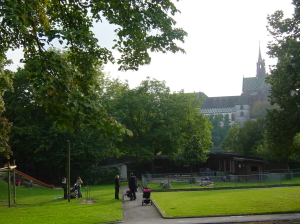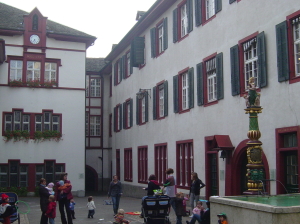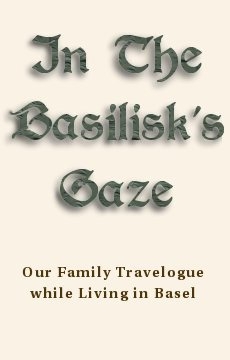Popping into France for Some Groceries
 Thursday, April 16, 2009 at 4:41PM
Thursday, April 16, 2009 at 4:41PM We’d been told about the higher cost of living in Switzerland, and even that meat was especially expensive. Perhaps the 20 Franc (A$24) per kilo import duty on meat should have raised our expectations too — we assumed this was essentially punitive. But it was still a strange feeling to stand at the supermarket fridge and see slim packets containing single chicken breasts selling for 38 Francs (A$46) per kilo. The cheapest meat available in the main supermarkets was turkey breast, a mere 34 Francs per kilo. Lamb chops were a staggering 65 Francs (A$78) per kilo. Indeed, most of the lamb here is imported from Australia or New Zealand. To avoid terrifying the customers too badly, the fresh meats are labelled with costs per 100g.
Given these prices, there’s a strong incentive to seek alternative sources, and we knew about the local habit of shopping just across the French border. © Gveret Tered
© Gveret TeredSource: Wikimedia Commons under GFDL
St-Louis in France is 3km northwest of Basel, but is more like a suburb than a separate township. The urban environment stretches right up to and through the border without a break. However, there is a notable difference in the housing on either side. On the Swiss side, the regular rows of well-maintained rectilinear apartment blocks project a sense of reserve and conservatism. On the French side, the houses have a rural, friendly character and are noticeably more rundown. It is as if you have stepped from a densely packed German city straight into a French countryside village.
Not everything is smaller in St-Louis though. The supermarkets are massive, bigger than anything in Basel itself. The cheaper cost of land, combined with the steady stream of Swiss border-hopping shoppers, has bloated them out of all proportion to their surroundings. And the prices are indeed lower. We have taken to doing at least one large shop per month across the border, in either France or Germany (the supermarkets in Weil Am Rhein turn out to be closer and cheaper, and people speak German which cuts down on the daily language-switch churn).
Also in Weil Am Rhein is a swimming centre called Laguna Badeland, just 5 minutes’ drive from the Paper Museum. With summer fading fast, we took the boys for a swim there soon after arriving. It was only when we reached the German border that we realised we had forgotten to pack our passports along with the swimming gear. We went back for them; the thought of being refused re-entry to Switzerland, with nothing but our wet swimming costumes on hand, was rather disturbing. It was a reminder that, while the borders are trivial to cross, doing so can have significant consequences.
Once at the pool, we found that they had an interesting new rule. Board shorts, in fact any bathing pants that weren’t skin tight, were prohibited. Allegedly the additional fabric in such garments results in too much dirt being deposited in, and to much water being withdrawn from, the baths. We’re sure it has nothing to do with the fact that the people who wear such costumes tend to be either young, rowdy males or observant, Muslim females (the web page on the new rule makes clear that the rule also applies to “bathing garments of other cultures”). Mark had to leave a 10 Euro deposit to borrow the least stylish pair of tight bathing shorts imaginable, as his swim shorts were deemed slightly baggier than his skin.
In addition to numerous pools and spas, Bade Laguna have three giant slides, including one called the Black Hole that is entirely dark in some twisting and dropping sections.  Given how eager Wiki and Loxon were to test these, we were forced to surrender ourselves to them as well. But at least we had someone to cling onto in the dark when the terror took hold, even if they were only three years old.
Given how eager Wiki and Loxon were to test these, we were forced to surrender ourselves to them as well. But at least we had someone to cling onto in the dark when the terror took hold, even if they were only three years old.
Meanwhile, we had found two childcare places for the boys at a well-recommended centre. The centre is inside a former 15th century Carthusian monastry which was converted into an orphanage in 1667. The original medieval wall surrounds expansive grounds that include a church, a school, a playground, a climbing wall and an enclosure for farm animals. Basel’s cathedral, just across the river, is clearly visible from most parts of the grounds. They have goats and pigs, which the children are allowed to feed and pet.  The whole place is such a wonderful change from the artificial, hyper-modern environment of the childcare centre in the CBD where the boys went in Sydney.
The whole place is such a wonderful change from the artificial, hyper-modern environment of the childcare centre in the CBD where the boys went in Sydney.
There is also a corresponding absence of bureaucracy, with so many fewer forms and rules that one starts to think something must be wrong. There are no parent’s sign-in sheets, no accident report forms for trivial scrapes, no detailed step-by-step hygiene instructions for taking your child to the toilet. Common sense and casual conversation prevail. Childcare workers in Sydney spend so much of their attention on satisfying the regulations of the Department of Community Services (DOCS) that it must surely detract from the attention they pay to the children. Here in Switzerland there simply isn’t the obsession with legal liability that there is in Australia. Perhaps this has terrible consequences if your child is involved in neglect or abuse. But it is amazingly refreshing to drop your child off with a chat, rather than a half dozen signatures. And as for the pigs in the yard, DOCS officials would probably have a heart attack.
